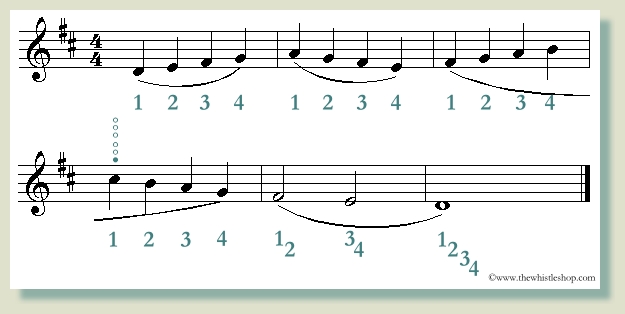Slurs & Ties
(And a brief introduction to Cross-fingering)
Slurs:
Up until now, we have been "tonguing" every note. A "slur" is playing one or more notes together without tonguing. This makes the piece flow more smoothly. The slur mark is printed below or above the notes. The first note of the slur is tongued, and all additional notes are played without tonguing. Avoid taking a breath in the middle of a slur.
One note about lesson piece below - notice the fingering for the C# note (in the 4th measure). The little finger on the right hand may be put down (if needed) to steady the whistle, and will not change the sound of the note. You'll notice that this finger can actually be left down on a number of other notes, without changing the sound of the note. Experiment with this - you'll be learning more about "Cross-fingering" (alternate ways to finger notes) as you progress.
Study the lesson below, listening to the sound clip - then play along as you listen. Remember to count along as you play.

Click here to hear the above lesson
Ties:
A "Tie" is similar to a slur, except that it connects two (or more) notes of the same pitch. When you come to a tie, you continue to count, but you only tongue the first note in the tie.
Study the lesson below, listening to the sound clip - then play along as you listen. This very simple looking lesson can be a little tricky to count at first, if ties are something new for you.

Click here to hear the above lesson
First Song (Revisited)
You'll remember this tune from our last lesson, except now we'll add slurs and ties. It may be a good idea to listen (without playing) quite a few times, then play it by yourself - to get used to making it flow smoothly - before playing along with the recording.
From this point on, we will not be printing the count below the tune, except when introducing new note values. We've also added a few "breath marks" to show you a good place to take a breath. The proper place to breath when playing is an entire subject by itself that we do not go into in depth in this tutorial. In general, the best place to take a breath is at the end of a "phrase" if possible, or at the end of a longer note. This is not written in stone by any means, you should find places to breath that make the song flow smoothly without sounding like you're playing using your last breath.

Click here to hear this tune played slowly Click here to hear this tune at full speed
In future lessons, we will cover many aspects of playing, including other time signatures, ornamentation and much more.
End of current free online tutorial

Copyright 1998 - 2021
The Whistle Shop
Privacy
Statement
Return Policy
